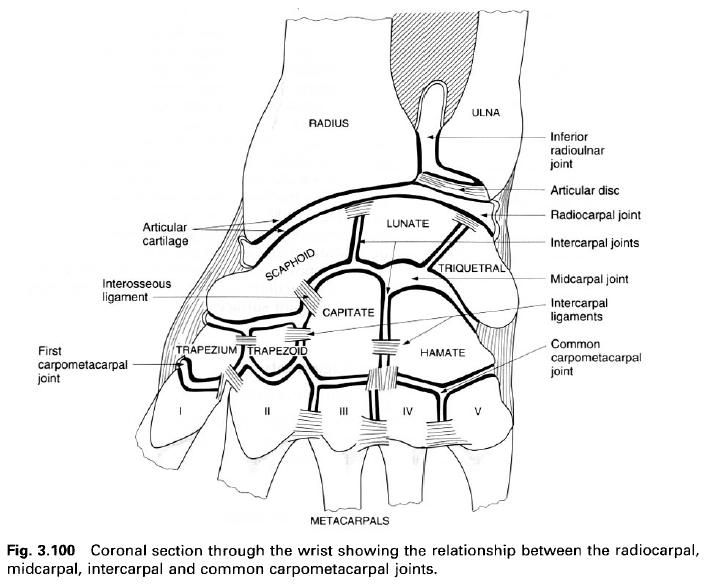The carpal bones are arranged in two transverse
rows between which is the important midcarpal joint. For the majority, the
joints between the adjacent individual carpal bones are of the plane synovial
type, permitting only slight movement between the bones involved. The only bone
which moves appreciably is the capitate.
Joints of the proximal row
Plane synovial joints exist between the distal
parts of the adjacent surfaces of the scaphoid, lunate and triquetral. However,
because these bones are bound together by interosseus, dorsal and palmar
intercarpal ligaments there is minimal movement between them.
The interosseus intercarpal ligaments are short
bands attaching to the margins of the joint surfaces involved in the
radiocarpal articulation. They unite the bones along their whole
anteroposterior length. The palmar and dorsal intercarpal ligaments are
transverse bands passing from scaphoid to lunate and from lunate to triquetral
on the anterior and posterior aspects of the bones respectively.
The pisiform rests on the palmar surface of the
triquetral and has a separate synovial joint with it, which is completely
enclosed by a thin but strong fibrous capsule. The pisiform is also anchored to
the hook of the hamate by the pisohamate ligament, and to the base of the fifth
metacarpal by the pisometacarpal ligament. These two ligaments resist the pull
of flexor carpi ulnaris, and transfer
its action to the hamate and base of the fifth metacarapal. In this way these
ligaments form extensions of the muscle.
Joints of the distal row
As in the proximal row, the four bones of the
distal row are united by interosseus, palmar and dorsal intercarpal ligaments,
with the joints between the individual bones being of the plane synovial type.
Because of these ligaments, movements between adjacent bones is minimal.
The interosseus ligaments are not as extensive
as in the proximal row, leaving clefts between the bones which communicate with
the midcarpal joint proximally, and with the common carpometacarpal joint
distally. Occassionally, the midcarpal and carpometacarpal joints communicate
with each other between the bones of the distal row. This occurs when one of
the interosseus ligaments is incomplete so that communication is around the
borders of the ligament, or when one ligament is absent(most commonly that
between the trapezium and trapezoid). Dorsal and palmar ligaments generally run
transversely across the appropriate surfaces of the bones, uniting trapezium to
trapezoid, trapezoid to capitate, and capitate to hamate.










0 коментара:
Постави коментар